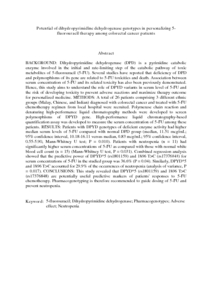Citation
Teh, Lay Kek and Hamzah, Sharina and Hashim, Hazwanie and Bannur, Zakaria and Zakaria, Zainul Amiruddin and Hasbullani, Zakaria and Kwong, John Siew Shia and Fijeraid, Henry and Md Nor, Azmid and Mohd Zailani, and Ramasamy, Prabu and Ngow, Harris and Sood, Suneet and Salleh, Mohd Zaki
(2013)
Potential of dihydropyrimidine dehydrogenase genotypes in personalizing 5-fluorouracil therapy among colorectal cancer patients.
Therapeutic Drug Monitoring, 35 (5).
pp. 624-630.
ISSN 0163-4356; ESSN: 1536-3694
Abstract
BACKGROUND: Dihydropyrimidine dehydrogenase (DPD) is a pyrimidine catabolic enzyme involved in the initial and rate-limiting step of the catabolic pathway of toxic metabolites of 5-fluorouracil (5-FU). Several studies have reported that deficiency of DPD and polymorphisms of its gene are related to 5-FU toxicities and death. Association between serum concentration of 5-FU and its related toxicity has also been previously demonstrated. Hence, this study aims to understand the role of DPYD variants in serum level of 5-FU and the risk of developing toxicity to prevent adverse reactions and maximize therapy outcome for personalized medicine.
METHODS: A total of 26 patients comprising 3 different ethnic groups (Malay, Chinese, and Indian) diagnosed with colorectal cancer and treated with 5-FU chemotherapy regimen from local hospital were recruited. Polymerase chain reaction and denaturing high-performance liquid chromatography methods were developed to screen polymorphisms of DPYD gene. High-performance liquid chromatography-based quantification assay was developed to measure the serum concentration of 5-FU among these patients.
RESULTS: Patients with DPYD genotypes of deficient enzyme activity had higher median serum levels of 5-FU compared with normal DPD group (median, 11.51 mcg/mL; 95% confidence interval, 10.18-16.11 versus median, 0.83 mcg/mL; 95% confidence interval, 0.55-5.90, Mann-Whitney U test; P = 0.010). Patients with neutropenia (n = 11) had significantly higher serum concentrations of 5-FU as compared with those with normal white blood cell count (n = 15) (Mann-Whitney U test, P = 0.031). Combined regression analysis showed that the predictive power of DPYD*5 (rs1801159) and 1896 T>C (rs17376848) for serum concentrations of 5-FU in the studied group was 36.6% (P = 0.04). Similarly, DPYD*5 and 1896 T>C accounted for 29.9% of the occurrences of neutropenia (analysis of variance, P = 0.017).
CONCLUSIONS: This study revealed that DPYD*5 (rs1801159) and 1896 T>C (rs17376848) are potentially useful predictive markers of patients' responses to 5-FU chemotherapy. Pharmacogenotyping is therefore recommended to guide dosing of 5-FU and prevent neutropenia.
Download File
![[img]](http://psasir.upm.edu.my/29679/1.hassmallThumbnailVersion/Potential%20of%20dihydropyrimidine%20dehydrogenase%20genotypes%20in%20personalizing%205.pdf)  Preview |
|
PDF (Abstract)
Potential of dihydropyrimidine dehydrogenase genotypes in personalizing 5.pdf
Download (85kB)
| Preview
|
|
Additional Metadata
Actions (login required)
 |
View Item |

